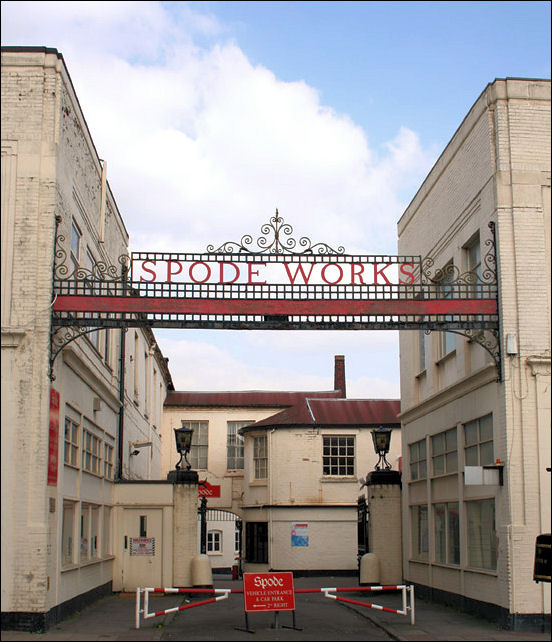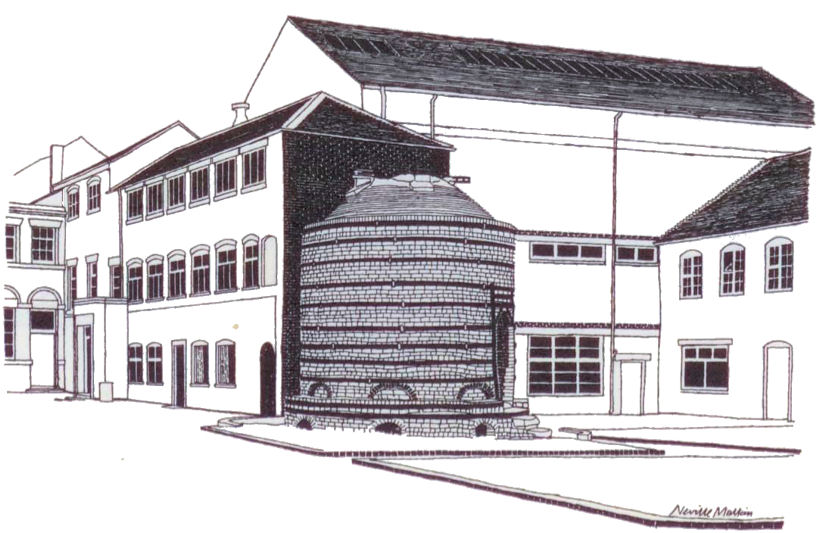
Listed Buildings
in Stoke-on-Trent and area
Spode Pottery Factory,
Church Street, Stoke
Area
Stoke |
Street
Church Street, ST4 1BS |
Heritage No.
10066a |
Grade
II |
Date Listed
21 Dec 2007 |
|
Building:
Spode Pottery Factory,
buildings 15, 16, 17 & 18 |
|
Location:
STOKE ON TRENT, Stoke
Grid Ref:
387625E 345285N |
|
Description:
Group of factory warehouses and the Courtyard of the Spode
Factory. |
Group of factory warehouses forming an ensemble marking the
principal entrance and the `China Bank' Courtyard of the Spode
Factory. Post 1829 with later alterations. Red Brick with slate
roofs, with some stone detailing.

Entrance to Spode
Pottery Works, Stoke
photo: Espresso Addict April
2007
DESCRIPTION
For clarity the description adopts the building numbering in the
2007 Historic Assessment by Wardell Armstrong. Overall the
listed buildings on this large site comprise the entrance group
and the principal courtyard to the east of the entrance, and
date from the early years of the Copeland epoch of the firm's
history.
|
Building 18 is a distinctive bow fronted counting
house or lodge in brick of two stories under a slate roof
which forms part of an ensemble of buildings defining the
principal entrance to the Factory site. It has a continuous
multi-pane window which curves around at ground floor level
with two six by six sliding sashes at first floor level.
There is a dentilled eaves cornice and string course between
the ground and first floors. The south west fašade of the
building appears to have been refronted as the dentilled
eaves do not continue around on this face, although an eight
over eight pane sliding sash on this facade appears to be
original.
The remainder of the building has had new window and door
openings at both ground and first floor levels. A curving
external stair provides access to the first floor and
connects the building to Building 17 which lies adjacent and
opposite Building 18 and is also connected to it by a
carriage arch. |
|
Building 17 is also largely of this earlier 1833
date. It is also of brick with a dentilled eaves cornice
under a pitched slate roof. There are a series of two- and
four-light top hung casements under segmental arches at
ground floor and a variety of C20 windows in original flat
arched openings at first floor. A door and window opening
and window under a concrete lintel have been inserted at
ground floor level. Internally the building has been
altered. |
|
Building 16 is a long warehouse building in brick under a
slate roof with three truncated stacks. It is single depth and
built on an undercroft, possibly the foundations of the building
which formerly stood on the site, which is slightly deeper and
contains examples of Copeland tiles which are fixed on built-in
benches within the undercroft. The building was originally three
stories with a fourth storey added later in the C19. As original
built, the building was symmetrical with a regular pattern of
windows and doors under segmental arches at ground floor which
was repeated at first and second floor. The third floor which
was added is taller with a series of nine tall three light top
hung paned casements. As originally constructed the building was
fireproofed to all floors (jack-arched construction is still in
situ).
Building 16 has been extended on a diagonal to connect if with
an earlier range on the north west side. This extension is also
of three stories under an apparently flat or shallow pitched
roof. It has a door and window at ground floor level and paired
windows under segmental arches at first and second floor. A
single tall three light window on the third floor matches
reflects those on the main range of Building 16.
This extension connects the long south western range of Building
16 with an earlier two storey brick range under a slate roof.
This is of seven bays and curves to join Building 15 via a
carriage arch. It has a series of six over six pane sliding sash
windows under stone lintels, set within recessed blind arches
separated by brick pilasters; all over a brick pediment defined
by a projecting string. The first floor windows are recessed
four over eight pane sashes with stone lintels set on a
continuous projecting string. This range has a delicately
moulded eaves cornice.
Some internal detailing survives including a stone stair
(thought to have originally been an external stair) within the
three storey extension and some ceiling roses, cornicing and
joinery although the Building 16 is much altered internally. |
|
Building 15 The final notable building of this phase
(1840-60) is Building 15 standing to the north east of Building
16 and connected to it via a three storey extension over a flat
arched passageway. The principal range of Building 15 is of
three storeys and has an eight bay, roughly symmetrical fašade
of brick under a hipped slate roof. A projecting flat roofed
entrance porch has been added at the north west of the building
as part of the 1930s refitting of the showrooms within the
building. There is a further door placed centrally flanked by
paired windows under segmental arched heads; windows at first
floor are also segmental headed whilst those at third floor have
stone sills and lintels. There is a slight projecting string
course immediately above the windows at ground floor. An arched
passageway formerly provided access around an adjacent bottle
oven.
Building 15 houses the present showrooms for the company
(replacing the earlier ones fronting Church Street). This
includes the `Blue Room', a long room at the front of the
building, open to the braced king post roof and housing the
famous blue transfer collection of the firm. The 1930s porch
gives access to a stair hall, panelled to dado height in light
wood with a sweeping stair with a panelled wreathed balustrade
surmounted by a brass handrail and lit by a tall arch-headed
stair window with marginal glazing. This leads to the imposing
first floor showrooms. The showrooms accessed through paired
double doors and are panelled with wood block parquet flooring.
The doors are rich wood with a contrasting inlay to give the
impression of a door panel and have brass door furniture. A
deep, gently curving cornice provides a transition to the
recessed skylight which occupies most of the ceiling. A series
of recessed glass-fronted and panelled niches provide display
space for some of the fine collection of Spode pottery retained
by the firm, including exceptionally rare examples of their best
work. Adjoining the southern end of the building is the base of
a bottle kiln: the only visible reminder of this essential
component of a pottery works. |
HISTORY
Stoke on Trent is synonymous with the pottery industry.
There has been a pottery on the site of the Spode Factory from
at least 1751 when documentary sources record that Benjamin
Lewis transferred a `newly erected' potworks to his son, Taylor
Lewis. The site passed through several hands until Josiah Spode
purchased it from Jeremiah Smith on the 29th February 1776 (the
adopted foundation date for the factory of 1770 is incorrect).
Josiah Spode, father of the company, was born at Lane Delph,
Staffordshire on the 23rd March 1733. Josiah went to work in a
local pottery and by 1849 was apprenticed to Thomas Whieldon, a
well-respected master potter in the district.
By the 1760s Josiah I had begun his own small pottery and he
entered into several partnerships before finally acquiring the
present Factory site.
Spode, like his neighbour and rival Josiah Wedgwood, rapidly
recognised the value of a more direct access to markets in
London and in 1778 sent his son, Josiah Spode II (1733-1827) to
take premises at No. 29 Fore Street, Cripplegate.
William Copeland joined the firm in 1784 and, following the
death of Josiah I in 1797, Copeland became an equal partner in
1805. Copeland became the sole owner of the firm in 1829,
whereupon the factory underwent extensive rebuilding and
enlargement: the listed buildings date largely from this heyday
period, and reflect the scale of the enterprise at its height.
The earliest plan of the site dates from 1833 {company archives)
and shows some of the buildings as standing. The precise use of
the various buildings has changed over the years, and their
original function awaits identification.
The firm remained in the Copeland family until 1966, trading
under a number of names. The firm was merged with the
Carborundum Group of Companies in 1966 and in 1971 reverted to
the original name `Spode'. It was subsequently merged with
Worcester Royals Porcelain Co to become Royal Worcester Spode
Ltd in 1976.
Throughout its history, Spode has been at the forefront of
innovation in pottery production: Josiah I is widely credited
with perfecting the manufacture and successful marketing of bone
china and in 1784 he perfected the technique of
transfer-printing on earthenware from hand-engraved copper
plates, essential to the phenomenal growth of the English
tableware industry.
Renowned as a commercial enterprise, the firm also won a high
reputation for its high standards of design and innovation. They
have also received a number of Royal Warrants since their first
as Potter and English Porcelain Manufacturer to HRH The Prince
of Wales in 1806, becoming Manufacturers of China to HM Queen
Elizabeth II in 1971.
Throughout its history Spode has produced a variety of wares
including bone china, stoneware, earthenware and Parian ware.
Spode's designs, particularly the original and much-copied
Willow pattern, remain extremely popular both here and abroad
and are still produced today. Astute marketing through their
London premises and negotiated contracts such as that with the
Hudson Bay Co to be their sole suppliers of earthenware from
1835 until the 1870s assured the success of the firm and have
ensured that it is seen not just as a national, but as an
international institution.
REASONS FOR DESIGNATION: The entrance and inner courtyard
buildings at Spode are designated for the following principal
reasons:
* the national and international renown of the Spode/Copeland
firm, one of the world's leading pottery concerns.
* Its unique status as the only one of the internationally
famous potteries in the area to remain on its original site.
* The contribution which the firm made to key technological
developments within the industry, specifically the perfecting of
bone china manufacture and the development of the blue
underglaze process which revolutionised the tableware industry,
and which took place on this site.
* As a reflection of the phenomenal growth of the British
pottery industry in the late C18 and C19.
* As a reflection of the historical development of the pottery
industry in Staffordshire.
* As a cohesive survival of buildings in a single area of an
otherwise much-altered site, which together reflect the scale
and character of this notable enterprise, and which read as an
inter-related group.

  
next: Church of St.
John, Newcastle Road, Trent Vale
previous: Stoke-on-Trent Railway Station
|
![]()

![]()
